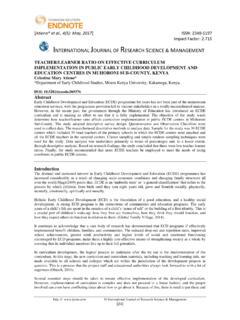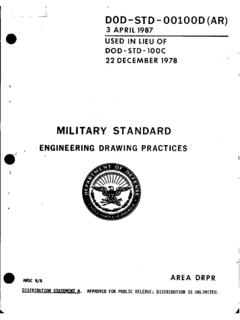Transcription of INTERNATIONAL JOURNAL OF RESEARCH SCIENCE …
1 [kanaje et al., 3(4): April, 2016] ISSN: 2349- 5197. Impact Factor (PIF): INTERNATIONAL JOURNAL OF RESEARCH SCIENCE & MANAGEMENT. IMAGE FUSION ALGORITHM BASED ON FASTCURVELET TRANSFORM. Pushpavati Kanaje Correspondence Author: Keywords: Discrete Fast Curvelet Transform, Fast Curvelet Transform, Image Fusion, Navigation images, Object detection Abstract This paper analyzes the characteristics of the Fast Curve let Transform that is second generation Curve let Transform and put forward an image fusion algorithm based on Fast Curve let Transform and discrete Fast curve let Transform.
2 Proposed algorithm in this article was applied to experiment of navigation image fusion and object detection image fusion. According to simulation result, the proposed algorithm holds useful information from source multiple images quit well. Introduction Image Fusion can be defined as combination of images (input quantity) from different sources (image sensors, cameras) with the aim to obtain new or more precise knowledge about the scene. Single Sensor Image Fusion System[4].An illustration of a single sensor image fusion is shown in The sensor shown could be a visible-band sensor such as a digital camera.
3 This sensor captures the real world as a sequence of images. The sequence is then fused in one single image and used either by a human operator or by a computer to do task. For example in object de0tection, a human Operator searches the scene detect objects such intruders in a security area. Single Sensor Image Fusion System This kind of systems has some limitations due to the capability of the imaging sensor that is being used. The conditions under which the system can operate the dynamic range, resolution, etc.
4 Are all limited by the capability of the sensor. For example, a visible-band sensor such as the digital camera is appropriate for a brightly illuminated environment such as daylight scenes but is not suitable for poor Fast Curve let Transform, illuminated situation found during night, or under adverse condition such as in fog or rain. Multi-Sensor Image fusion System: Multi-sensor image fusion systems overcome the limitations of a single sensor vision system by combining the images from these sensors to form a composite image.
5 Shows an illustration of multi-sensor image fusion system. In this case, an infrared camera is supplementing the digital camera and their individual images are fused to obtain a fused image. This approach overcomes the problems referred to before, while the digital camera is appropriate for daylight scenes, the infrared camera is suitable in poorly illuminated ones Multi Sensor Image Fusion System In recent years, many researchers recognized that multi-scale transform are very useful for analyzing the information content of images for the purpose of fusion.
6 So, various alternatives based on multi-scale transform have been proposed , such as Laplacian pyramid-based, gradient pyramid-based, ratio pyramid-based, et al. The basic idea of multi-scale transform is to perform a multi- resolution decomposition on each source image, then integrate all these decompositions to produce a composite representation. The fused image is finally reconstructed by performing an inverse multi-resolution transform. The pyramid-based method is simple and good performance generally. However, in the pyramid reconstruction, it is sometimes unstable, especially when there are multiple significant differences in the source image, the fused image will appear plaques.
7 Wavelet transform is a multi- http: // (C) INTERNATIONAL JOURNAL of RESEARCH SCIENCE & Management [1]. [kanaje et al., 3(4): April, 2016] ISSN: 2349- 5197. Impact Factor (PIF): INTERNATIONAL JOURNAL OF RESEARCH SCIENCE & MANAGEMENT. resolution analysis method, too. It can decompose an image into an approximation and the lowest level of detail in different directions at different scales, and it is one of the most commonly used image fusion methods. Wavelets are very effective in representing objects with isolated point singularities, while wavelet bases are not the most significant in representing objects with singularities along lines.
8 As a consequence, the method based on the Wavelet tranform can not excavate the edge quality and detail information. To above deficiencies of wavelet transform,Donoho et al. proposed the theory of Curve let transform,which takes edges as the basic description element and is well suitable for the characteristics of image. The RESEARCH result show that Curve let transform theory can be better used in image feature extraction, image fusion, etc., and good results were obtained. But they used the first generation of Curve let transform.
9 In 2004, Candes, who proposed the theory of second generation of curve let transform, and in 2005 the fast implementation of second generation Curve let transform algorithm is given. Compared with first generation curve let transform, the second generation can overcome many of the shortcoming, not only has the simple structure, but also greatly reduce the amount of data redundancy, and its fast algorithm is easier to be understood. Image fusion algorithm based on fast curvelet transforms Images can be fused in three levels, namely pixel level fusion, feature level fusion and decision level fusion.
10 Pixel level fusion is adopted in this paper. It represents fusion of visual information of the same scene, from any number of registered image signals obtained using different sensor. The goal of pixel-level image fusion can broadly be defined as: to represent the visual information present in any number of input images, in a single fused image without the introduction of distortion or loss of information [5] .One of the most important characteristic of curve let transform is anisotropy, which can represent the contour of image more sparsely and provide more information for image processing.




